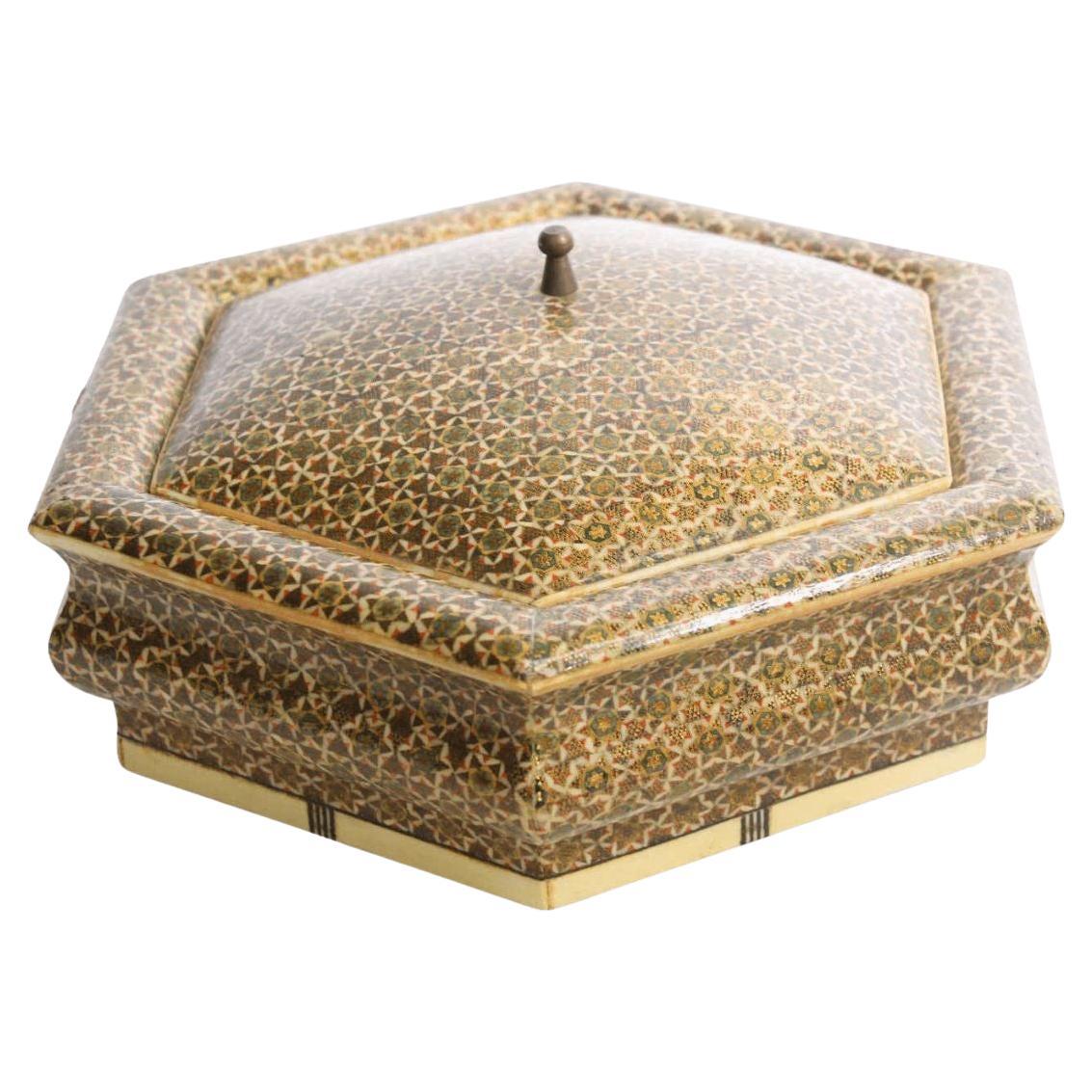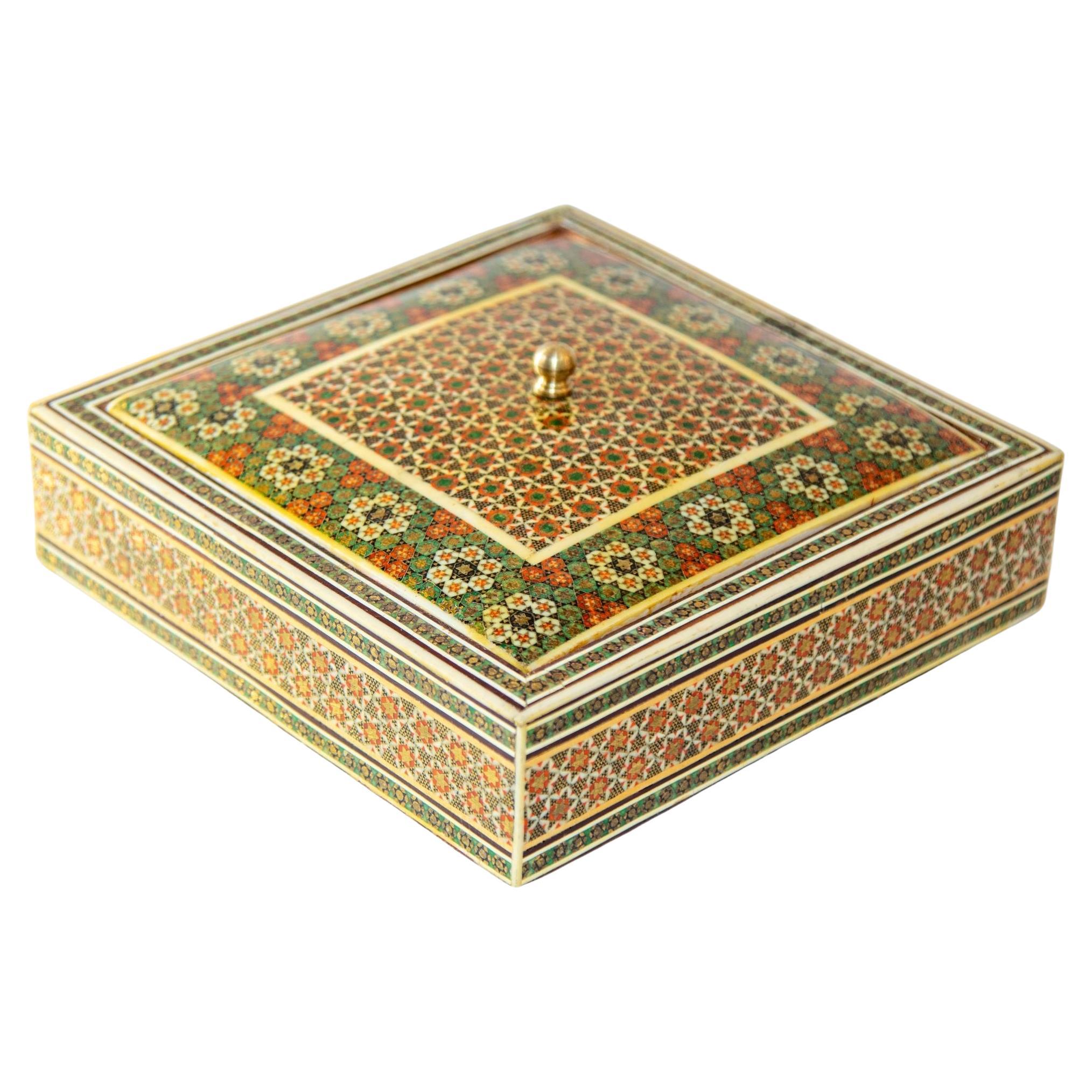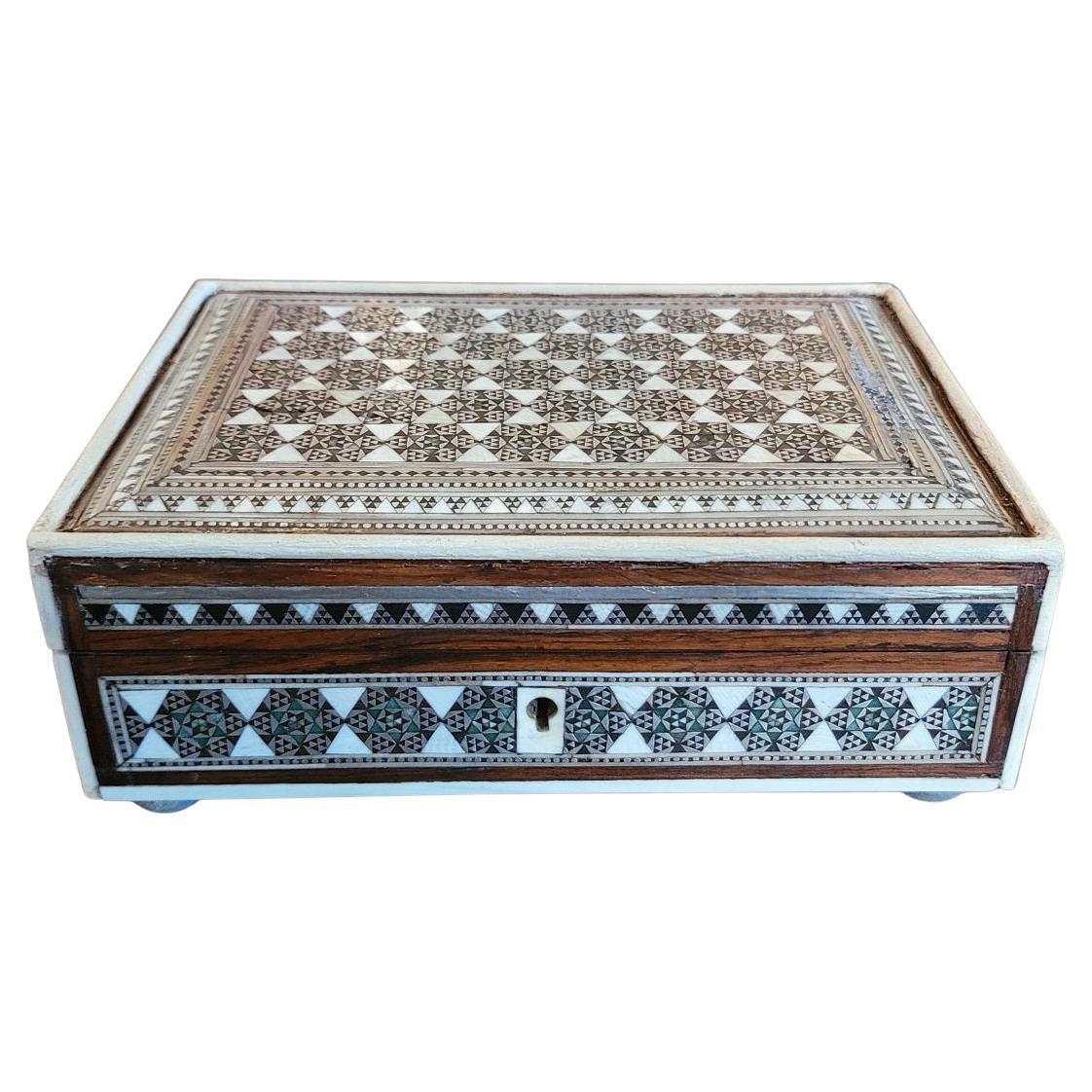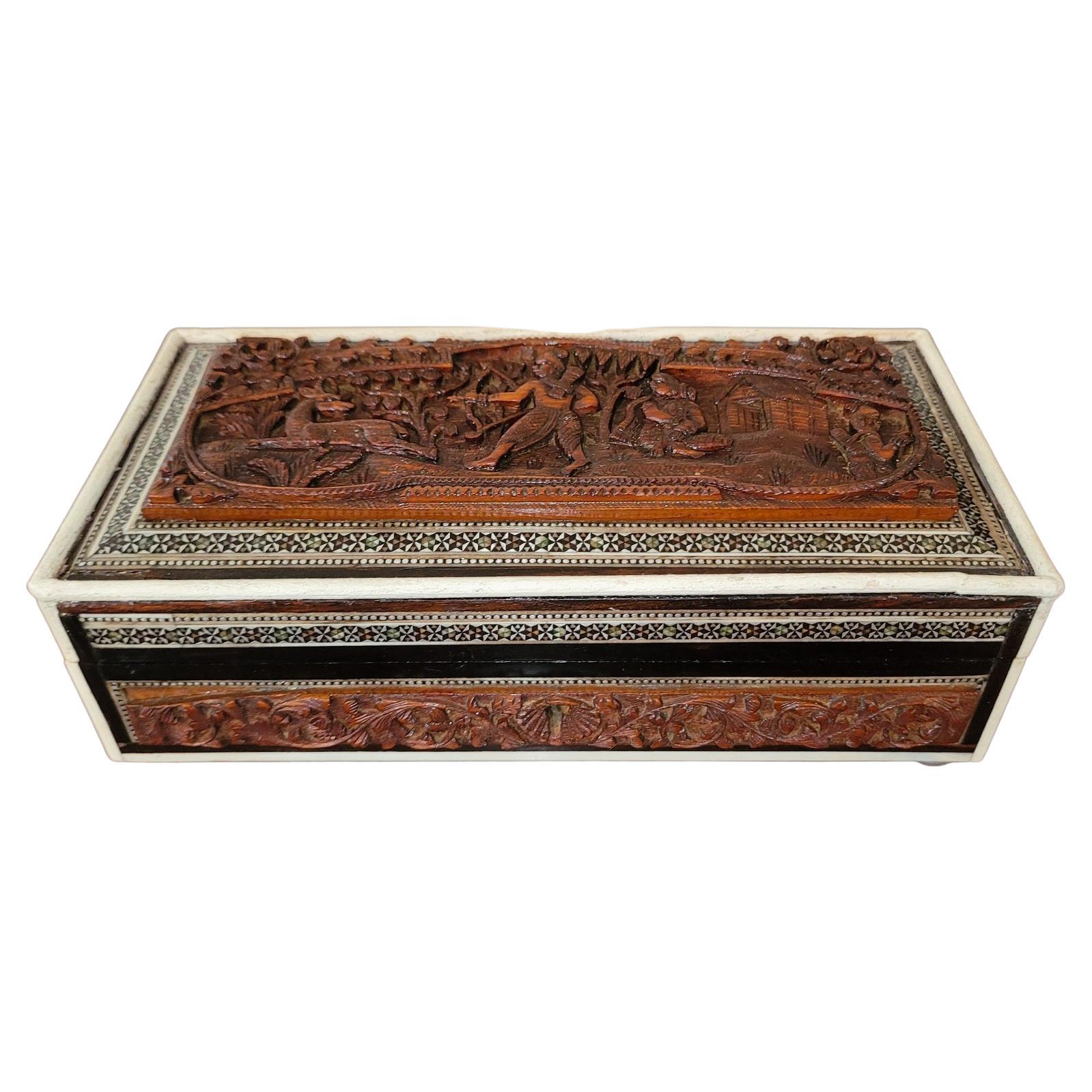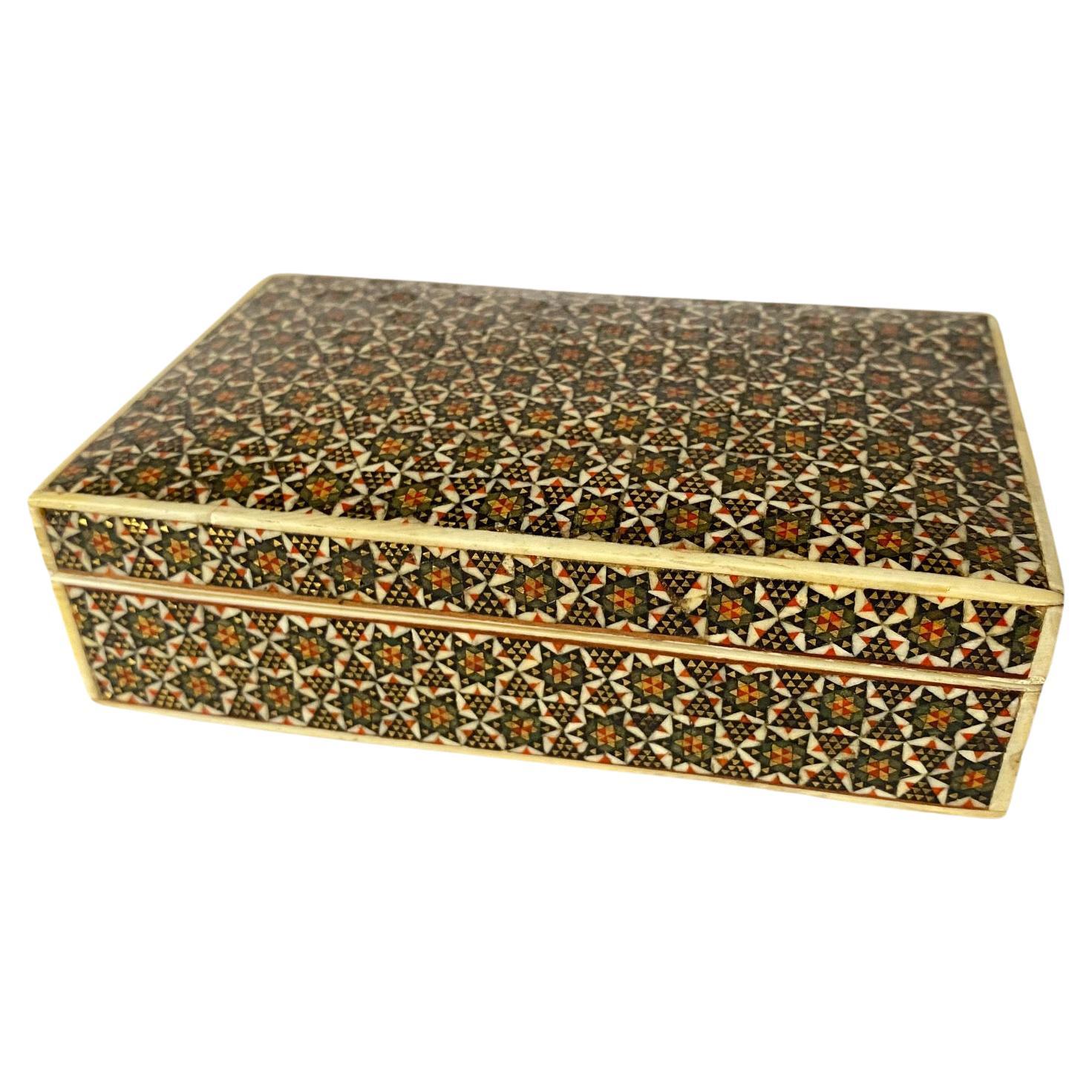Items Similar to ORIGINAL ANTiQUE ANGLO INDIAN EXPORT SADELI MICRO MOSAIC BUSINESS CARD CASE
Want more images or videos?
Request additional images or videos from the seller
1 of 14
ORIGINAL ANTiQUE ANGLO INDIAN EXPORT SADELI MICRO MOSAIC BUSINESS CARD CASE
About the Item
Royal House Antiques
Royal House Antiques is delighted to offer for sale this lovely, super decorative antique Islamic Anglo Indian Sadeli Micro Mosaic Card Case
A wonderfully original find, this isn’t one of the much later reproductions but a period example, it is super decorative and very rustic
The condition is perfect for the age, there will be some age and use related patina marks but mostly its in fine order
Dimensions
Height:- 1cm
Width:- 10cm
Depth:- 7.5cm
Please note all measurements are taken at the widest point, if you would like any additional or specific measurements please ask
Any questions please feel free to ask before you bid
- Dimensions:Height: 0.4 in (1 cm)Width: 3.94 in (10 cm)Depth: 2.76 in (7 cm)
- Style:Anglo-Indian (Of the Period)
- Materials and Techniques:
- Place of Origin:
- Period:
- Date of Manufacture:20th century
- Condition:Wear consistent with age and use. Minor fading.
- Seller Location:GB
- Reference Number:1stDibs: LU2823339310112
About the Seller
4.6
Gold Seller
These expertly vetted sellers are highly rated and consistently exceed customer expectations.
Established in 2012
1stDibs seller since 2017
1,716 sales on 1stDibs
Typical response time: <1 hour
- ShippingRetrieving quote...Ships From: United Kingdom
- Return PolicyA return for this item may be initiated within 14 days of delivery.
More From This SellerView All
- 19th Century Anglo Indian Vizagapatam Carved Sandalwood Box Micro Mosaic InlaysLocated in GBWe are delighted to offer for sale this lovely 19th century Anglo-Indian Vizagapatam carved sandalwood and inlaid box Mid-19th century Anglo-Indian Vizagapatam carved sandalwood box...Category
Antique 19th Century Indian Anglo-Indian Decorative Boxes
MaterialsWood
- DECORATIVE ANTIQUE ORIGINAL KASHMIR PLAYiNG CARD BOX WITH TWIN COMPARTMENTSLocated in GBRoyal House Antiques Royal House Antiques is delighted to offer for sale this lovely, super decorative antique Kashmir playing carved box with period paper mâché finish A wonderful...Category
20th Century European Victorian Decorative Boxes
MaterialsWood
- Anglo Indian Export Hardwood Elephant Inlaid Side Lamp End Wine Table FlowersLocated in GBWe are delighted to offer for sale this stunning small Anglo Indian hand carved Rosewood & inlaid side table I have two other versions of this table listed under my other items, o...Category
Antique 19th Century Indian Anglo-Indian End Tables
MaterialsHardwood
- Enormous Original Paint Anglo Indian Teak Magistrates Table SpecialLocated in GBWe are delighted to offer for sale this monumental early 20th century Anglo Indian solid teak hand painted Magistrates dining table A truly staggering piece of furniture, I would ...Category
20th Century Indian Anglo-Indian Dining Room Tables
MaterialsTeak
- Rare Anglo-Indian Export Taj Mahal Elephant Hardwood Inlaid Side Lamp Wine TableLocated in GBWe are delighted to offer for sale this stunning and very rare Anglo Indian hand carved rosewood and inlaid side table depicting the Taj Mahal I have two other versions of this ta...Category
Antique 19th Century Indian Anglo-Indian End Tables
MaterialsHardwood
- Antique Anglo Indian Military Campaign Trestle Desk & Armchair Hardwood & BrassLocated in GBWe are delighted to offer for sale lovely vintage Anglo Indian Rosewood with ornate brass inlay Campaign trestle desk with matching directors armchair. A highly decorative and wel...Category
Antique 19th Century Indian Anglo-Indian Desks and Writing Tables
MaterialsBrass
You May Also Like
- 19C Anglo Indian Sadeli Mosaic Greeting Card CaseLocated in Dallas, TXPresenting a superb 19C Anglo Indian Sadeli Mosaic greeting card case. Made in or around Bombay, India circa 1880. This is a greeting card case used for holding your greeting cards or business cards of the day ! The body of the case is made from sandalwood and it is fully overlaid with bone and highly intricate Sadeli Mosaic made up of thousands of micro mosaic pieces of bone, ebony, silver/pewter and semi precious stone. The workmanship is stupenduous !!!! This case is almost museum quality. One or two very, very minor losses of mosaic mainly where the top meets the body but otherwise near mint ! SADELI MOSAIC: “Anglo Indian boxes were made in India for the English residents from the early part of the 18th century. They were brought back or sent back to England usually by the people who had commissioned them. From the beginning of the nineteenth century they were imported more commercially, although not in any significant numbers until the middle decades. They were very highly valued, especially the early ones, to the extent that the designs were copied on late 19th and early 20th century tins. The ancient art of Sadeli Mosaic is said to have been introduced from Shiraz in Persia via Sind to Bombay, a long time before the Anglo Indian boxes were made. It was a technique, which required a high degree of skill and patience. It was executed very lavishly, in that the frequent cuts wasted a great amount of the precious materials used. The workmanship was however more than commensurable to the value of the materials. Ivory, silver, pewter (or other metals), wood and horn were cut into faceted rods which were bound together to form geometric patterns. When the glue has set, the rods were sliced in transverse sections. This gave the maker a number of angled circular pieces in the original pattern. Several variations of patterns could be achieved by combining the materials in different ways. The ivory was sometimes dyed green to give an extra color. The mosaic pieces in a combination of patterns, often separated by ivory, ebony, horn or silver stringing were used to veneer sandalwood boxes. In the early boxes, which date from the turn of the 18th to the 19th century, there are large panels of mosaic covering tops and sides of boxes. It took incredible skill to cover such large areas without any shakes or wavering of the pattern. The corners and joins on these boxes are impeccably matched. The makers (reputed to be Persian) of Sadeli mosaic made in the first two decades of the 19th century displayed a total understanding of the qualities of the different materials they used. They combined substances, which can expand and contract according to atmospheric conditions with others, which are hard and unyielding. The result was a sharp definition of the lines and patterns, which made up the whole design. On the early boxes the designs look deceptively simple. The fact is, they emerged from a culture, which had mastered geometry and understood how to generate a pattern from a set number of points. The patterns are so harmoniously combined that their incredible complexity is not immediately apparent. The earliest Sadeli boxes...Category
Antique Late 19th Century Indian Anglo Raj Decorative Boxes
MaterialsBone, Precious Stone, Ebony
- Anglo Indian Micro Sadeli Mosaic Inlaid Hexagonal BoxLocated in North Hollywood, CAAnglo Indian Moorish style micro mosaic inlaid jewelry box with lid. Intricate inlaid Anglo Indian box with floral and geometric Moorish Sadeli design in an octagonal shape form with micro mosaic marquetry, very fine artwork. Museum collector piece like the one in Doris Duke Islamic Art Museum. The repeating geometric patterns of Sadeli Mosaic...Category
Early 20th Century Moorish Jewelry Boxes
MaterialsFruitwood
- 1950s Anglo Indian Micro Sadeli Mosaic Inlaid Jewelry BoxLocated in North Hollywood, CA1950s Anglo Indian Micro Sadeli Mosaic Inlaid Jewelry Box. DIMENSIONS: 7ʺW × 7ʺD × 2.5ʺH. Indo Persian Moorish style micro mosaic inlaid jewelry box with lid. Intricate inlaid Anglo ...Category
Mid-20th Century Indian Moorish Decorative Boxes
MaterialsFruitwood, Bone
- 19C Anglo Indian Bombay MOP Sadeli Mosaic Trinket BoxLocated in Dallas, TXPRESENTING a LOVELY 19C Anglo Indian Bombay MOP (Mother of Pearl) Sadeli Mosaic Trinket Box from circa 1875-85. Gorgeously detailed and hand-crafted ‘sadeli mosaic’ inlay, from the Bombay Area, with deep greens with silver, pewter, mother of pearl, bone and ebony in geometric patterns. The box case, is made of sandalwood but completely covered in MOP, bone, faux ivory, ebony and mosaic inlay. Edged with faux ivory and banded with a different pattern of sadeli mosaic. Some minor damage to the top (repair is obvious in pics) and ivorine replacements to some edging, but it still a BEAUTIFUL BOX and of real QUALITY! The mosaic work is FABULOUS! Box opens to reveal its original blue velvet lining. It sits on 4 (recently added) silvered button feet. SADELI MOSAIC: “Anglo Indian boxes were made in India for the English residents from the early part of the 18th century. They were brought back or sent back to England usually by the people who had commissioned them. From the beginning of the nineteenth century they were imported more commercially, although not in any significant numbers until the middle decades. They were very highly valued, especially the early ones, to the extent that the designs were copied on late 19th and early 20th century tins. The ancient art of Sadeli Mosaic is said to have been introduced from Shiraz in Persia via Sind to Bombay, a long time before the Anglo Indian boxes were made. It was a technique, which required a high degree of skill and patience. It was executed very lavishly, in that the frequent cuts wasted a great amount of the precious materials used. The workmanship was however more than commensurable to the value of the materials. Ivory, silver, pewter (or other metals), wood and horn were cut into faceted rods which were bound together to form geometric patterns. When the glue has set, the rods were sliced in transverse sections. This gave the maker a number of angled circular pieces in the original pattern. Several variations of patterns could be achieved by combining the materials in different ways. The ivory was sometimes dyed green to give an extra color. The mosaic pieces in a combination of patterns, often separated by ivory, ebony, horn or silver stringing were used to veneer sandalwood boxes. In the early boxes, which date from the turn of the 18th to the 19th century, there are large panels of mosaic covering tops and sides of boxes. It took incredible skill to cover such large areas without any shakes or wavering of the pattern. The corners and joins on these boxes are impeccably matched. The makers (reputed to be Persian) of Sadeli mosaic made in the first two decades of the 19th century displayed a total understanding of the qualities of the different materials they used. They combined substances, which can expand and contract according to atmospheric conditions with others, which are hard and unyielding. The result was a sharp definition of the lines and patterns, which made up the whole design. On the early boxes the designs look deceptively simple. The fact is, they emerged from a culture, which had mastered geometry and understood how to generate a pattern from a set number of points. The patterns are so harmoniously combined that their incredible complexity is not immediately apparent. The earliest Sadeli boxes...Category
Antique Late 19th Century Indian Anglo-Indian Jewelry Boxes
MaterialsSilver
- Anglo Indian Micro Mosaic Inlay Jewelry BoxLocated in New York, NYExquisitely crafted early 20th century Anglo Indian micro mosaic Sadeli box with gorgeous antique Persian geometric pattern. The finely detailed box featu...Category
Early 20th Century Indian Anglo-Indian Jewelry Boxes
MaterialsFruitwood, Bone
- 19C Anglo Indian Carved Padouk Wood and Sadeli Mosaic BoxLocated in Dallas, TXPRESENTING A LOVELY 19th century Anglo-Indian Carved Padouk Wood and Sadeli Mosaic Box, featuring a carving of a Hunt Scene. Made circa 1870 in Bombay, India during the Rule of th...Category
Antique Late 19th Century Indian Anglo-Indian Jewelry Boxes
MaterialsSilver, Pewter

